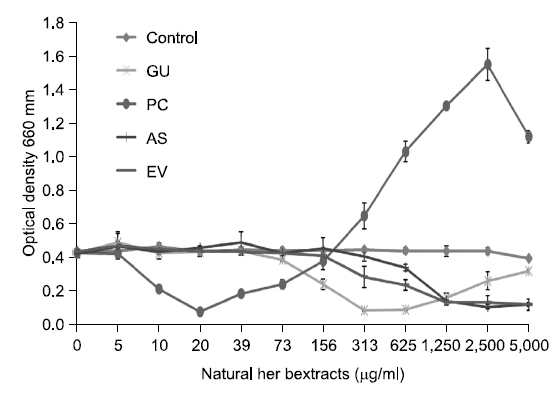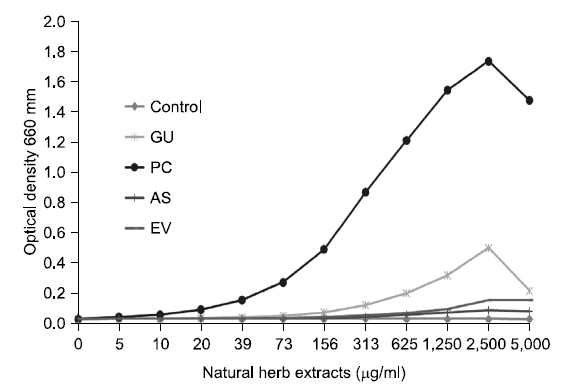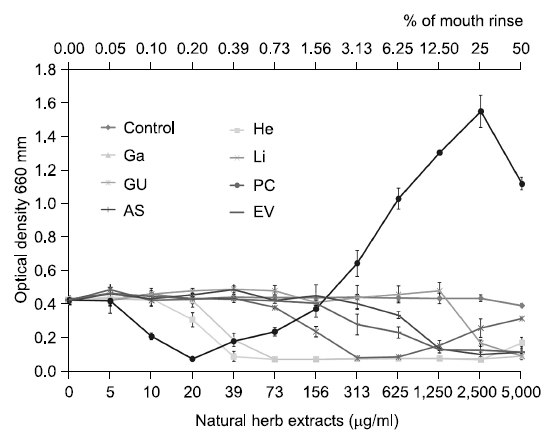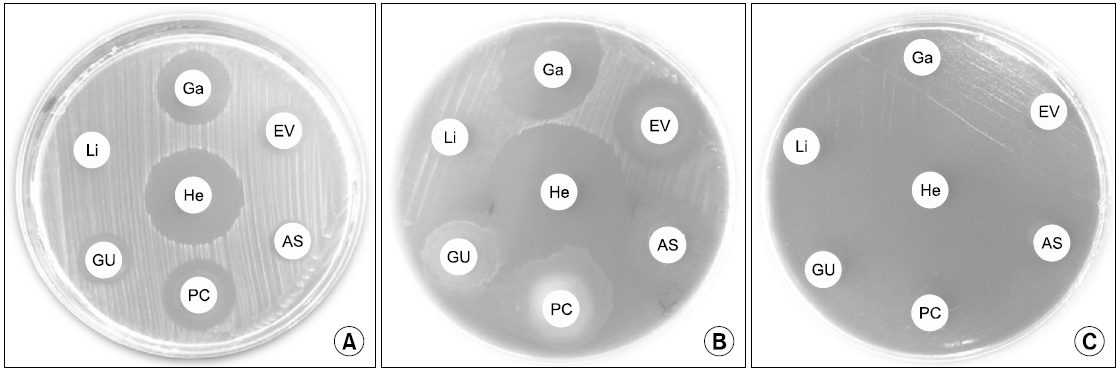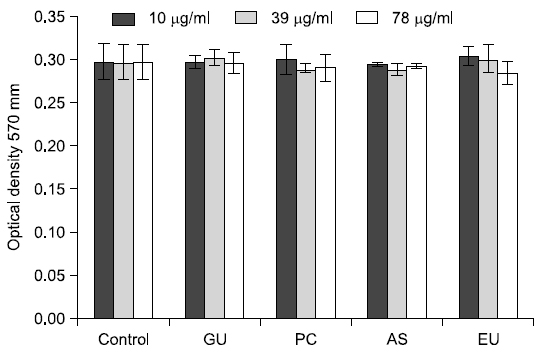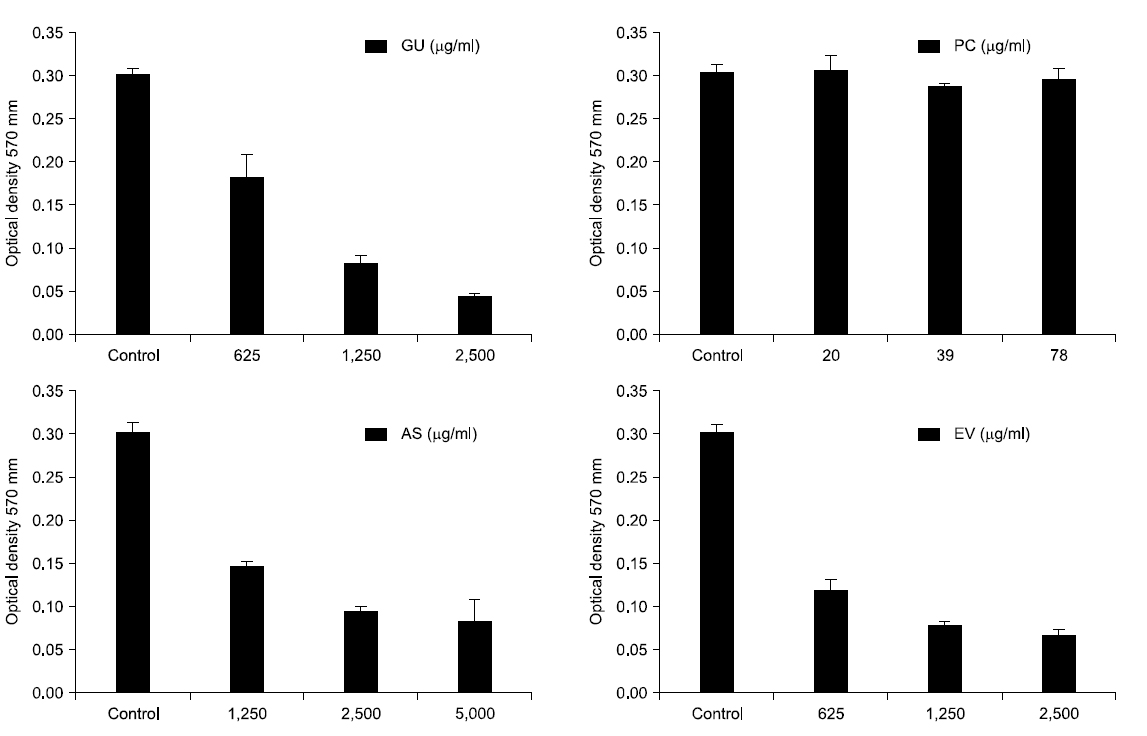



This study attempted to identify the possibility of natural herbal extracts as an alternative, preventive agent of caries by comparing antimicrobial activities between natural herbal extracts and mouth rinsing solutions against Streptococcus mutans. Natural herbal plants were extracted with distilled water and ethanol, respectively, to measure the minimum growth inhibitory concentration of S. mutans depending on concentration, and among which, solvents showing high antimicrobial activity were selected to compare their antibiotic effects with those of mouth rinsing solutions. Also, to determine the concentration of natural medicinal herbs that can be used safely in the oral cavity, the extracts were treated to the normal gingival fibroblast cells depending on concentration in order to determine its cytotoxicity using MTT. In terms of the minimum growth inhibition concentration, the growth inhibition of S. mutans was more excellent in the ethanol extract than in the distilled water. When the minimum growth inhibition concentration was compared, Psoralea corylifolia of natural herbal ethanol extracts, and Hexamedine (Bukwang Pharm., Korea) of mouth rinsing solutions inhibited growth of S. mutans at the lowest concentration. When the minimum bactericidal concentration was compared, P. corylifolia of natural herbal extracts, and Hexamedine and Garglin (Dong-A Pharm., Korea) of mouth rinsing solutions eliminated S. mutans at a low concentration. The human gingival fibroblast was treated with natural herbal ethanol extracts at the minimum growth inhibition concentration of 10, 39, and 78μg/ml. As the result, no cytotoxicity was found. When this was treated at different minimum bactericidal concentrations, natural herbal ethanol extracts showed cytotoxicity except P. corylifolia.
본 연구는 천연한방 식물 추출물의 치아우식 예방제제로서 가능성을 평가하고자 구강 양치용액과 함께
Dental caries is a bacterial infectious disease accompanied by the demineralization process and a multifactorial disease caused by an interaction among bacteria in the plaque, food and saliva1). The plaque is composed of bacteria, protein and polysaccharides when streptococci are accumulated in the mouth after bacteria adhere to the initial acquired pellicle. Then this creates acids, forming a cluster solidly and causes demineralization2). Therefore, the reduction of bacteria in the plague can prevent diseases caused by the plague and proper management is extremely important.
For preventing dental caries, several physical methods including toothbrushing are used. In addition to this, a variety of oral rinses are used as auxiliary tools to prevent dental caries. In general, oral rinses are used to feel refreshingness from toothbrushing and remove bad breath3) and known to reduce the numerical value of oral bacteria, especially,
The effects of these natural herbal plants vary depending on the extraction or refinement method. Jang et al.17) reported that no antimicrobial effect was observed in the hot water and ethanol extracts, but a strong antimicrobial effect was observed in the sugar extract when the antimicrobial effects of
Therefore, this research aimed to identify the possibility of natural herbal extracts as alternative preventing agents of dental caries by comparing the antimicrobial effects of natural herbal extracts on
1. Materials of the study and method for extraction
1) Selection of the natural herbal
The four natural herbal used in this study were selected based on their low price and accessibility and purchases from kyeongdong market, seoul and stored at refrigiator (Table 1).
[Table 1.] The List of Medicinal Plants Used for This Study

The List of Medicinal Plants Used for This Study
2) Extraction and concentration of the natural herbal extract
The four natural herbal extract were extracted using distilled water and ethanol as solvent. The distilled water extraction were performed as follows: 50 g of the four herbs were allowed to settle and deposit in 500 ml of distilled water for four days, filtered, pressure concentrated and frozen at −70℃ deep freezer (DF8510; IlShin BioBase Co. Ltd., Namyangju, Korea) for 12 hours after which dried using freeze dryer (FD8508; IlShin BioBase Co. Ltd.). The freeze dried extracts were weighted, and dissolved in distilled water and dimehylsulfoxide (DMSO; Sigma, San Jose, CA, USA) at 10 mg/ml, sterilized using 0.22 μm polyvinylidene difluoride (PVDF) filter (BIOFIL, Ashland, VA, USA).
3) Selection of mouth rinsing solutions
The mouth rinsing solutions used in this study were selected based in their diversity of ingredients and market share, and sterilized using 0.22 μm PVDF. Description of each medicine are in Table 2.
[Table 2.] The List of Mouth Rinsing Solution Used for This Study
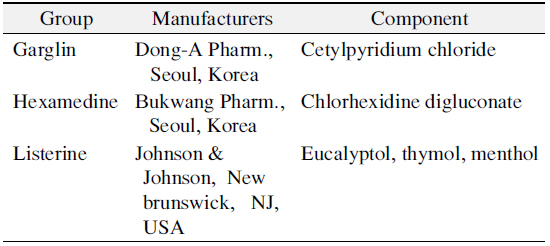
The List of Mouth Rinsing Solution Used for This Study
The bacteria used in this study is
The cultured bacteria were counted using Petroff Hausser counting chamber (Hausser Scientific, Horsham, PA, USA) and diluted to 1×106 cells/ml at TSB. 180 μl of liquid TSB was dispensed to each well of 96-micro well plate and 180 μl of the four herbs and mouth rinsing solutions were dispensed to each well serially diluted with 20 μl bacterial culture and incubated for 12 hours. Cell growth were measured using spectrophotometer (precision microplate reader, Emax precision; Molecular Device Corp., San Diego, CA, USA) by measuring absorbance at 660 nm.
To study minimal bactericidal concentration, live cell were counted at lower and higher concentration than MIC. Bacteria cultured at ethanol extract of the natural herbal extract were 1/10 diluted in phosphate buffered saline (PBS). The diluted cell were serially diluted to 106 factor. 100 μl of diluted bacteria culture were inoculated at brain heart infusion (BD Biosciences) agar plate using triangle spreader (SPL Life Science, Pocheon, Korea) and cultured for 36 hours. The plate with 200 colonies were selected and the total cell in 100 μl were calculated based on their dilution factor.
5. Disk diffusion method of natural herbal extract and the mouth rinsing solution
To measure antibacterial activity against
To observe the presence of cytotoxicity in the ethanol extract of the natural herbal extract, the activity of normal gingival fibroblast were measured using MTT (Thiazoly Blue Tetrazolium Bromide 98%; Sigma). Bacteria were inoculated at 1×105 cells/ml in 96-micro well plate with different concentration of the herb extract and cultured for 24 hours. Then the cultured supernatant were eliminated and 100 μl of 4 mg/ml MTT solution in PBS (Gibco BRL, Grand Island, NY, USA), sterilized with 0.22 μm PVDF filter, were carefully dispensed and mixed gently while setting the plate in the ground. Then the plates were cultured in CO2 incubator (MCO-18AC; Sanyo Electric Co. Ltd., Gunma-ken, Japan) for 4 hours, removed the reaction solution, eluted formazan using 200 μl of DMSO, and shook 30 minutes using shaker (SH 30; Finepcr, Seoul, Korea) after covering with aluminum foil. After 30 minutes of shaking, 100 μl of the elution were transferred to new 96-micro well plate and measured the absorbance at 570 nm using spectrophotometer. All experiments were triplicated.
1. Measurement of the minimum growth inhibition concentration of natural herbal extracts by solvent
1) Minimum growth inhibition concentration of natural herbal distilled-water extracts against S. mutans
As a result of measuring the minimum growth inhibition concentration against
2) Minimum growth inhibition concentration of natural herbal ethanol extracts against S. mutans
As a result of measuring the minimum growth inhibition concentration of natural herbal ethanol extracts, the bacterial growth did not happen at 20 μg/ml for
2. Measurement of basic optical density of natural herbal ethanol extracts
To determine if the results of the minimum growth inhibition concentration of natural herbal ethanol extracts stem from
As a result of measuring the minimum growth inhibition concentration against
As a result of measuring the minimal bactericidal concentration against

Effect of Various Concentration of Several Natural Herbal Extracts by Ethanol and Three Mouth Rinsing Solutions on Streptococcus mutans
5. Measurement of bacterial growth inhibition zone with disc diffusion method
As a result of measuring the bacterial growth inhibition to compare the antimicrobial activity against
6. Measurement of MTT cytotoxicity of natural herbal ethanol extracts
As a result of treatment at 10, 39, and 78 μg/ml minimum growth inhibition concentration, to determine if the natural herbal ethanol extracts are toxic to the normal gingival fibroblasts, the optical density value showed a similar pattern to the control group that has no extracts added (Fig. 6). In addition, as a result of treatment by differing the concentration of each extract based on the measurement values of the minimal bactericidal concentration, the other extracts except
Dental caries is a disease caused by the interactions between bacteria, foods, and saliva within the dental plaque and its major causative germ is known as
To manage the dental plaques, many people are using various preventive auxiliary devices. Among which, mouth rinsing solutions is being used for the purpose of preventing gum disease, removing dental plaque and mouth odor, and preventing dental caries. The mouth rinsing solutions includes various ingredients, which have different effects. Therefore, ongoing studies on the various ingredients of the mouth rinsing solutions have been made. Shin and Lee23) reported that the mouth rinsing solutions containing NaF, cetylpyridinium chloride (CPC), and ursodeoxycholic acid suppresses the generation of dental plaques. Choi et al.24) demonstrated that the mouth rinsing solutions containing CPC and triclosan has gingivitis index- reducing effect, dental plaque-suppressing effect, and mouth odour-suppressing effect. But such synthesized chemical materials are resistant to antibiotics although they suppress the growth of microorganisms residing in the oral cavity10). For this reason, researchers are putting more interest in natural materials like medicinal herbs, as more effective and stable alternate products.
Accordingly, this study selected
Natural herbal plants were extracted with distilled water and ethanol, respectively, to measure the minimum growth inhibitory concentration of
Also, to determine the concentration of natural medicinal herbs that can be used safely in the oral cavity, the extracts were treated to the normal gingival fibroblast cells depending on concentration in order to determine its cytotoxicity using MTT.
As a result, the natural herbal plants extracted with ethanol solvent showed that the higher the concentration, the better its growth-suppressing effects against
As a result of comparing the minimum growth inhibition concentration against
To identify the cytotoxicity of natural herbal ethanol extracts, extracts were treated to the normal gingival fibroblast cells by concentration. Based on the minimum growth inhibition concentration, extracts were treated at 10, 39, or 78 μg/ml as the concentration when antimicrobial effects began to be shown. As a result, the group treated with extracts showed a similar pattern to the control group, which suggested that the group treated with extracts is nontoxic. Further, based on the minimal bactericidal concentration, extracts were treated depending on concentration. As a result, the extracts other than
Taken together, 4 kinds of natural herbal extract showed a similar antimicrobial effect when compared with the mouth rinsing solutions, synthesized chemical substance. Therefore, the natural herbal extracts are expected to be used as an alternative preventive agent for dental caries if using them at an appropriate concentration.
In this study, the antibacterial effects of mouth rinsing solutions and natural herbal extracts on
These results demonstrate that the antibacterial effect of the four kinds of natural herbal extracts was similar to the effect of mouth rinsing solutions, which are synthetic chemicals. Therefore, it is thought that natural herbal extracts can be commercialized as alternative dental caries preventive agents by adding proper concentration.



